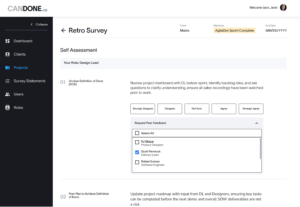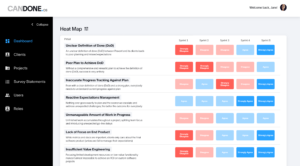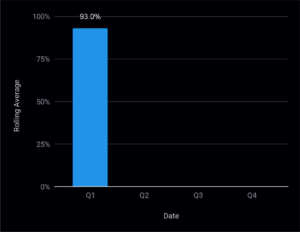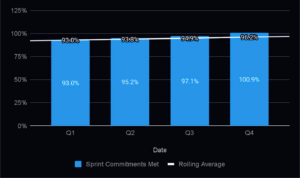The Praxent Difference
Solving the human challenges that lie at the heart of digital transformation.
At Praxent, we believe
human engineering is
a critical competency to
Command Your Future™
in the digital age.
People are at the heart of all challenges within digital transformation.
→ Understanding customer needs
→ Organizational dysfunction
→ Engineering team miscommunication
→ Poor hiring decisions
People problems are poorly understood
→ They often seem subjective and inconsistent
To unlock progress, we must lean in to defining, measuring, and solving for those human challenges.
Jump to:
Digital Products
How we build customer-winning experiences backed by data.

Enterprise Solutions
How we create an architecture built for change and backed by a culture of agility.

CanDone.os
How we implement repeatable processes that target the causes of software execution failure and increase delivery performance.

CAN/DO
How we measure the soft skills of a high-impact technology employees to build teams that deliver value fast.

Command your Future™
In the digital age, your technology is your business. It powers your products and how you deliver them to your customers. Commanding your future in financial services means keeping up with changing customer expectations and offering a unique value proposition to outpace the competition. It requires flexibility, agility, and adaptability. That translates to custom, proprietary technology.
This is where the human challenges come in.
Our approach
We believe the organizations that lean into the complexity and find ways to turn their human challenges into something:
✓ Defined ✓ Measurable ✓ Repeatable, will win.
Human-Centered Product Design
Shift from simply digitizing a transaction based on the systems powering it to embracing human-centered design. By leveraging behavioral science, user research insights, and data, you can create customer experiences that address unmet customer needs and build brand loyalty.
Critical components for a human-centered customer experience in financial services
Trust
- Challenge: Customers judge your trustworthiness on your digital user experience. When that experience doesn’t meet the expectations set by other technology experiences like Netflix or Amazon, they start to question your reliability. Worse, you’re asking them for their most private information and permission to transact their money.
- Solution: Building customer trust digitally comes down to a few areas: consistency, usability, attention to detail, security, and aesthetics.
Customer Value
- Challenge: Personalized service is about more than remembering someone’s name. It’s about predicting their needs and offering financial products that beat out the competition because you have more decision-making data. Something that’s often easier to do in person when data hasn’t been operationalized.
- Solution: Personalization online requires a data strategy that touches every part of the organization and sets a standard for consistency and quality.
Communication
- Challenge: Financial products are complex. That’s why people choose to work with institutions to manage their finances. The industry terms you use daily internally don’t mean anything to the customers and add complexity to a task they’re often reluctant to complete. Worse, it often obfuscates the true value of the product.
- Solution: Save the jargon for the board meeting and focus on building empathy with customers by speaking to them directly.
Meaning
- Challenge: Finance can be transactional by nature. Where customer service with your bank teller, financial planner, or insurance broker used to bridge the gap, creating customer connection and brand loyalty, it’s different in digital.
- Solution: Find ways to align your brand with your customers’ goals as they experience your digital channels to create a personal connection in the digital age.

Related Services
UX Strategy
User Research
Customer Journey Maps
UX Design
Design Systems
Ameritas Case Study
Answering the age-old question: what exactly happens to my retirement fund if I change my contributions?
Ameritas’ 401K administration app, My Plan Connection, takes the complexity of retirement investing and simplifies it. Led by user research and behavioral science, their intuitive experience helps customers envision their future through the decisions they make today.
The Evolutionary Enterprise Architecture
Shift from a siloed technology and IT department to an organization with technology leaders seeded in every department advocating for customer needs, data availability, organization-wide consistency, and speed to market. Prioritizing a modern core infrastructure is the first key to unlocking enterprise agility.
Critical components for a future-proofed architecture
Standardized Core Technology
- Challenge: Standardization is the core challenge for enterprise financial technology organizations. Pre-technology operational silos have translated into silos within the technology and data that block innovation attempts.
- Solution: Standardize technology, data, and DevOps across the broader organization but allow for local customization. This will unlock data, automation, and innovations such as Generative AI.
Decision Making
- Challenge: When transformations fail, this is almost always a key reason. When decision-making is too high up in the organization, the decisions are made with too little context by people with insufficient time to make the decision in a timely matter – often resulting in changing priorities and failed execution fatigue.
- Solution: Decentralize decision-making across the organization. Empower lower-level managers and teams with the authority to make decisions relevant to their tasks and expertise. Which brings us to our next point. →
Shared prioritization & shared goals, focused on value-delivered
- Challenge: Silo’ed goals produce siloed results and hamper cross-functional collaboration. When teams are measured by the number of screens or story-points delivered, their contribution to the company’s growth becomes obfuscated and easy to misinterpret.
- Solution: Align the definition of success for your teams with profitability and aim to standardize outcome-based goals across the company to incentivize teams to collaborate to succeed.
Decentralize Deployment Approval
- Challenge: Too often, compliance and security are the unfortunate bearers of bad news when it comes to software deployments. Centralizing these core requirements in siloed departments results in too-late discoveries requiring rework and delaying milestones.
- Solution: Employing shift-left principles to embed compliance, security, and quality control earlier in the development lifecycle enables organization-wide accountability for meeting requirements.
Related Services
Architecture Assessment and Design
Full-Stack Development and Systems Integration
DevOps and Cloud
Data Strategy
Predictable Software Delivery
Shift from an unpredictable and inefficient software execution process to an operating model built by software developers for software developers. Our proprietary CanDone.os method helps technology organizations turn software execution into a science, maximize developer productivity and predictability, and improve employee satisfaction.
The impact of adopting software delivery best-practices:
20-50%
INCREASE IN Developer efficiency
40%
increase the quality and stability of code
5-10x
faster PRODUCT delivery
Critical Components of CanDone.os
Focus on Failure
- Challenge: There are hundreds of ways for development teams to optimize their output. However, they can quickly become overwhelming and feel disjointed from the team’s most important work.
- Solution: Similar to pilots and surgeons, focus only on preventing the causes of failure. We distilled them into a checklist of 7 expectations that each role could do to prevent failure.
Role Clarity
- Challenge: There’s rarely a one-size fits all approach to software teams and the roles each person plays due to the variety of skill sets and experience within people. This can make it difficult to clearly set expectations for each project role.
- Solution: We documented 11 roles on software development teams (and some people may fill multiple roles) and defined the expectations for each role.
Easy Feedback
- Challenge: Team members can often identify when another is not meeting the expectations of their role. However, providing feedback to team members when emotions, personal responsibility, and team dynamics are involved is a challenge we see across all software teams.
- Solution: We enabled team members to ask for peer feedback targeted to the 7 expectations detailed for their role. Feedback can be simply the response to a sliding scale from strongly disagree to strongly agree, or team members can also provide a comment. Either way, the team member gets direct, specific feedback on their performance in a non-subjective way.

Measurable
- Challenge: Team leaders struggle to understand why a team is failing to deliver reliably or how they might be able to increase their productivity.
- Solution: We created a data-driven report that helps leaders analyze 1. Which team members are struggling to meet their expectations, and 2. Which challenges the team are facing together that are leading to a delivery failure.

The History of CanDone.os
The challenge
As a firm whose profitability hinges on our ability to meet our software delivery commitments on time, delivery execution is a critical metric for us. When we failed to meet our quarterly goal of 95% client-agreed sprint commitments met for the first time in over ten years, we set to work analyzing the root causes of the failure to ensure it never happened again.
 The challenge was best practices in software delivery can be overwhelming to establish across a technology organization of 120. So, instead of focusing on the hundreds of things the team could do to improve, we focused on only those that would definitely result in failure.
The challenge was best practices in software delivery can be overwhelming to establish across a technology organization of 120. So, instead of focusing on the hundreds of things the team could do to improve, we focused on only those that would definitely result in failure.
The solution
After identifying the 7 root causes of failure (or hazards as we named them), we documented the one repeatable thing that each of the 11 roles on our software development teams could personally do to prevent the failure, based on our learnings from 20+ years of software development. 77 expectations in total.
After a failed attempt to ask people to consult a wiki for their day-to-day jobs, we realized that we needed to consistently reinforce these expectations as part of their day-to-day. We created a post-sprint self-assessment sent to each team member where they were asked on a sliding scale from strongly disagree to strongly agree whether they had met the 7 expectations of their role.
The survey then doubled as
- A way to ensure every employee had clarity on the expectations of their role in a way that was reinforced every two weeks.
- A heat map across the team of each hazard to identify the team-wide challenges that they could bring into their sprint retro as an actionable agenda to solve it together.
The result
In the year that followed, we saw a steady improvement in sprint commitments met across our sprint teams. 3 months after implementing our CanDone.os operating model, we returned to our 95% sprint commitments met and saw a steady across the rest of the year. We ended closing the year with 100.9% of client-agreed sprint commitments met.

The future
Since then, we’ve turned our operating model into a software product for both our teams and our clients’ teams to use, helping them reinforce their own repeatable behaviors.
CanDone.os
CanDone.os is the operating model we use at Praxent to ensure reliability for all our client projects. We can also implement it within your technology organization to drive development productivity, delivery reliability, and team satisfaction.
Quantifying High-Impact Employees
Shift from subjective assessments of employee soft skills to a defined set of values that ensure you hire a high-impact technology team member. Team members with CAN/DO values drive more business value, say “can-do” instead of “can’t”, require less leadership overhead, and operate more proactively and reliably.
Care Deeply
To be passionate about and committed to your vision
Always Deliver
To be trusted to do what we say we will do
Never Settle
To consistently and respectfully recommend improvements
Do it Together
To never operate in a black box and leave you guessing
Own The Outcome
To embrace accountability with a no-excuses attitude
In a world of ‘can’t’ say ‘CAN/DO’
To seek to understand you first, responding with a ‘yes-and’
Critical Components of a CAN/DO Team Member
How we Identify Core Values in Employees
At Praxent, we utilize the WHO hiring process, a three-part interview process that includes a biographical interview. We review their entire work history from university to where they are now and look for stories that display our core values or stories that breach them. Any values or competencies that have not been directly addressed are then taken into the final interview with targeted questions that will likely surface the core value if it exists within the candidate.
How we Reinforce These Behaviors
The CAN/DO values are woven into every aspect of life at Praxent. Here are some of those ways. When managers or peers provide feedback, positive or constructive, they tag the core values the person embodied. We give awards to employees who display an exceptional commitment to our values each year. We survey the team each quarter on how well our organization lives up to our core values. We use our values to guide us in difficult decisions. Our core values not only define but inspire the behaviors of our team.
Related Services
Outsourced product designers
Outsourced software engineers
Outsourced program managers
Nymbus Case Study
Accelerating cloud-native core banking implementations with high-impact engineers
Balancing scale with speed and customer experience. Nymbus, a core banking system, accelerated its system implementations through a strategic partnership with Praxent.
Nymbus cracked the code for scale through a strategic partnership with Praxent. Niche expertise in core banking systems integration and a focus on soft skills to enable interface with critical clients directly.
Ready to Command your Future™ with us?
At Praxent, we believe Human Engineering is a critical competency
for companies to command their future, turn their ‘can’ into ‘done’, and
say CAN/DO to the changing customer needs that power growth in the digital age.



